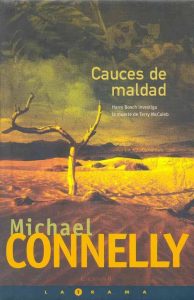
In this encyclopaedia of the crime novel that is Sangre en los estantes by Paco Camarasa (1950-2018), Michael Connelly (1956-) is described as a writer who has managed to update the classic detectives with whom the noir genre began. One of his creations is Hieronymus Bosch (yes, the same name as the painter), a cop in Los Angeles, who also works as a private eye in some novels, such as the one entitled The narrows. In this book we find a classic problem of conic sections passed through the filter of the crime novel and with the background of the desert landscapes of the state of Nevada. “Everything was reduced to primary schools geometry. I had two of the three vertices of a triangle and I needed the third”, confesses Bosch, and continues: “It was that easy and that difficult at the same time. To get to that point, I had the perimeter of the triangle. I sat down, opened the notebook to a blank page and started working with the map. I remembered that the mileage recorded in the rental car of one of the missing men was 528 kilometres. That distance would be the total of the three sides of the triangle. I already knew, thanks to the notes on the map, that one side of the triangle – from Zzyzx to Las Vegas airport – was 148 kilometres long. That left 380 kilometres for the two remaining sides. This figure could be distributed in various ways, placing the remaining side of the triangle in an infinite number of possible situations on the map”. With this data, would the reader be able to tell the geometric location of the other vertex of the triangle? You bet it, the answer is an ellipse: as the sum of the distances from the unknown vertex to the two known vertices is constant (and equal to 380 kilometres), the remaining vertex of the triangle describes an ellipse with its foci on the two known vertices.
Connelly doesn’t tell us if Detective Bosch realized that he was handling an ellipse, and although I could be wrong, I doubt that the author was aware that he was handling one of the conics that caused so much sleeplessness for the venerable Greek mathematicians. Nor did Bosch need mathematical help to locate the third vertex. As Bosch himself admits, the possibilities are initially enormous: “My drawing took the third possible vertex of the triangle to the Grand Canyon at the other end of Arizona, or to the north, to the forbidden military zone under the command of the air force base at Nellis”. But in due course the idiosyncrasies of the crime genre came into play, and the detective, without the need to go to Apollonius or Archimedes, found the solution: the third vertex is the town of Clear (which corresponds to the real Crystal) and the reasons are convincing: “Clear was a town of brothels and services derived from such businesses”, and that fitted perfectly with the profile of the suspected murderer. Moral: we should not forget that, depending on the matter, paid sex can solve problems for which mathematics does not have a clear answer.

Leave a Reply